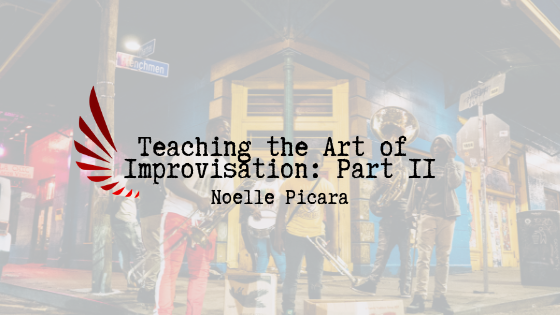As I pointed out in Part 1 of Teaching the Art of Improvisation, teachers are inherent improvisers. They have the uncanny ability to think quickly on their feet. And while they need and have the ability to improvise, it is essential that teachers pass down the art to their students. Providing students with the opportunity to learn the art of improvisation, how to learn, and how to respect it will equip that student to approach the world differently.
I know first hand the impact that the principle of improvisation can have on you. Growing up, I was taught in the rigid and standardized disciplines that are characterized by an unwavering order — disciplines like classical piano, and dances like ballet. While there can be pros to learning the principles taught within these structured environments, there are cons to be had as well. These walls that are built around students’ ability to be flexible often cause anxiety, an unnecessary fear of being wrong, and a constant emphasis on being the best all the time. Zoe Keating talks about how she started in improvisation, after dealing with performance anxiety in classical music, and developed her unique fusion of electronic, classical, and improv music.
Teaching students the art of improvisation is giving them the chance to look at the world differently. It empowers our students with the skills, flexibility, and passion for making a real difference in the world and promoting positive change. We are able to give them a space to say: it is ok if I make a mistake because I can learn from it.
I was first introduced to improvisation as a teenager and, honestly, it changed my life. My entire outlook on life changed because of it. And ever since then, I strive to live my life differently. To live it with flexibility. Improv has shown me (and inspired me to teach my students) that you have the resiliency to face the future. It has also shown me better and more productive ways to collaborate with others that I work with and to teach that collaboration to my students.
The path to improvisation can be likened to the 5 Rhythms dance structure. These main rhythms are different, yet they can be intertwined. One pillar of improvisation is that getting stuck is not the end. Don’t let getting stuck or your students getting stuck lead to bitterness or complaining. That will only sap your motivation.
The first rhythm, in 5 Rhythms, is a flowing dance, which is characterized by a very calm state and slow, smooth movements. It is methodical and driven like an educational routine. If you contrast that to the second rhythm, a staccato type dance with short, quick movements, you are presented with something very different. You are confronted with friction – the thought that something in the routine is not quite right and the drive to take action and create change. In life, this looks like noticing that something is not quite working and feeling the motivation to change it.
These staccato moments can lead to the feeling of being stuck that I talked about and further lead to the third rhythm, a chaotic state. While the traditional classroom model, with its structure and poise, is very well-intentioned, it can often exacerbate this chaotic state. That is when it is important to adopt the fourth rhythm: a lyrical, improvisational approach to your student’s education. You can coalesce the chaos in something new. Something beautiful. And solidify your student’s education in a new way.
The fifth rhythm is another essential rhythm for teachers, which is stillness. The ability to stop, take a moment, and reflect on their experience. The time that a teacher takes to pause and assess will not only benefit them, but their students as well.
Teachers are born improvisers, and it is our charge to instill this invaluable trait, as exemplified by the 5 Rhythms, in our students. Let us teach our students that the rhythm of life requires flexibility, passion, and fresh eyes.

